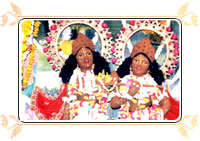

Chandan Jatra, the Sandalwood Paste Festival
Dr. Subas Pani
 The construction of the chariots starts on Akshaya Trutiya, the third day of the bright fortnight of Vaisakha, with ritual fire worship. This takes place in front of the palace of the King of Puri and opposite the main office of the Puri temple. On this day, the new agricultural season starts and farmers start ploughing their fields. This day also marks the beginning of the summer festival of the deities, also known as the sandalwood festival or Chandan Jatra, which lasts for three weeks. In this festival, the representative images of the presiding deities are taken out in colourful processions and given a ceremonial boat ride in the Narendra tank everyday. In an interesting demonstration of the assimilative character of the Jagannatha cult, Madanmohana and Rama Krishna, representing Jagannatha & Balabhadra partake in the festival with the representatives' images of the presiding deities of five main Shiva temples of Puri. These are curiously known as Pancha Pandava, the five brothers of the Mahabharata story. Later the deities have a ritual bath in a small temple in the middle of the tank, in stone tubs filled with water, sandalwood paste, scents and flowers.
The construction of the chariots starts on Akshaya Trutiya, the third day of the bright fortnight of Vaisakha, with ritual fire worship. This takes place in front of the palace of the King of Puri and opposite the main office of the Puri temple. On this day, the new agricultural season starts and farmers start ploughing their fields. This day also marks the beginning of the summer festival of the deities, also known as the sandalwood festival or Chandan Jatra, which lasts for three weeks. In this festival, the representative images of the presiding deities are taken out in colourful processions and given a ceremonial boat ride in the Narendra tank everyday. In an interesting demonstration of the assimilative character of the Jagannatha cult, Madanmohana and Rama Krishna, representing Jagannatha & Balabhadra partake in the festival with the representatives' images of the presiding deities of five main Shiva temples of Puri. These are curiously known as Pancha Pandava, the five brothers of the Mahabharata story. Later the deities have a ritual bath in a small temple in the middle of the tank, in stone tubs filled with water, sandalwood paste, scents and flowers.
This sandalwood festival culminates in the Snana Jatra, the Bathing Festival on the full moon day of the month of Jestha. On this day, the presiding deities descend from their seats on an elevated platform in the sanctum sanctorum, the bejewelled throne. They are bathed in 108 pots of water brought from the suna kua, the golden well and assume the elephant form on the special bathing platform, close to the Eastern boundary wall of the temple. From that day the deities remain in symbolic and ritual convalescence for about two weeks. They are barred from view of the ordinary devotees. Only three special patta chitras, traditional Orissan paintings of natural colours on cloth stiffened with starch, known as Anasara Pattis, are strung on a bamboo screen hiding the deities from public view, can be seen by the public. During this period, the deities are given only roots, leaves, berries and fruits to cure them from their indisposition. This ritual is a reminder of the strong tribal elements in the genesis and evolution of the Jagannatha cult. The progeny of Lalita, daughter of the original tribal worshipper Biswabasu, chieftain of hunters, and the Brahmin priest Vidyapati, are known as daitapatis or daitas. They have almost exclusive privilege of serving the Lord during the convalescence and through the entire period of Ratha Jatra or the Festival of Chariots.
Designed, developed and hosted by
इस वेबसाईट का निर्माण, विकास, होस्टिंग एवं रख-रखाव द्वारा
Ministry of Electronics and Information Technology
इलेक्ट्रॉनिक्स और सूचना प्रौद्योगिकी मंत्रालय
![]()